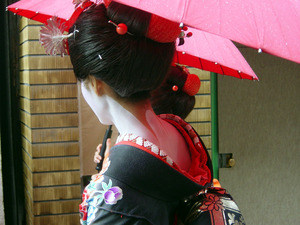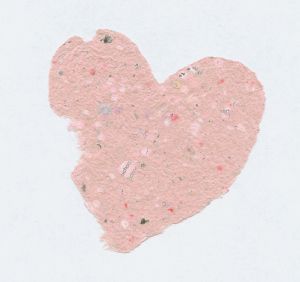Karyukai, the flower and willow world, has existed in Japan since the mid-eighteenth century. It is a part of the Japanese tradition that honors arts, traditions, codes of conduct, and more. There are many examples of performers, entertainers, and artisans that reside in this world, but perhaps the most intriguing is the geisha.
The geisha herself by name is a “person who lives by art” and her entire purpose is to carry on the oldest traditions of Japan in music, art, flower arranging, ceremonies, song, dance, and entertainment. She is the confidant of her clients and a prime example of passion and perfection in the arts. Her profession is to sell dreams and she is “a cultural possession of [her] city”. The numbers of true geisha are dwindling in the face of modern lifestyles, but it was not always this way.
Around the time of the early seventeenth century there were men who were considered jesters of the pleasure quarters. These men were everything from serious and talented musicians and dancers, to the tricky fools much like those of the European courts. The more accomplished, especially those proficient in playing the shamisen, began to be known as geisha. These geisha sometimes acted as advisors for the daimyo they served. However as cha-tate onna (tea-brewing women), odori-ko (dancing girls), and geiko (an “arts child”, often drum-bearers at this time) began to promote themselves as artists and not just prostitutes, the female profession of geisha was created. By 1800 the word “geisha” was primarily used in reference to women, even though there were still men in the profession. These female geisha were not bound by the rules of the women in the pleasure quarters. The quarters of the geisha were not walled in, they could come and go as they chose, they were not required to take sexual partners, and overall made their living through skill and wit.
With the development of the geisha came the beginnings of the karyukai, and hanamachi, or “flower towns”, began to grow in major cities, namely Kyoto and Tokyo. These towns were and still are entirely self-sufficient. They have no local government powers though they do bear a local administration in charge of booking, finance, registration, and event management for the resident geisha. Within the hanamachi are ochaya (the teahouses); okiya (the homes of the geisha); schools in dance, singing, instruments, and other arts; Shinto shrines and Buddhist temples; a theater for performances; and more.
In earlier times a geisha’s only family was in the okiya. Many children were sold into the okiya households in the event of kuchi berashi, which meant that their biological family could not afford to feed all of its members and as such the parents would sacrifice one or two children so that they might adequately care for the remaining. Unfortunately many of the girls cast out of their biological families ended up working as prostitutes or onsen geisha (the geisha of bathhouses who entertained little and sold their bodies often). The lucky few were accepted into an okiya and became a part of the larger world of geisha within the hanamachi.
Life for these girls in the okiya was not much easier than the less fortunate girls of the brothels. They entered the okiya as a tamago, or “egg”, and acted as a maid to the household, doing chores such as laundry, cooking, cleaning, serving, and aiding the maiko and geisha of the household with any needs they had. During this time they observed the highly traditional world within the hanamachi and this observation was meant to prepare them for the maiko training they would have in their teenage years. Yet this difficult world in the okiya was still more liberating than the lives of normal Japanese women. The girls sold into servitude as tamago would eventually have the opportunity to gain an education in the arts and become more independent, make her own money, and possibly run her own okiya or ochaya in her later years. She was not bound to arranged marriages and could chose her lovers, though many love affairs remained secret to protect both the client’s and the geisha’s reputations.
In modern times life in the okiya is still just as traditional, but not quite as difficult and girls enter the karyukai by choice. Yet while in today’s world entering the life of the hanamachi and okiya is a choice of free will, it comes as a vast culture shock to most and thus the retention rate of new recruits is low. Though Japan values its traditions of old it is widely a modernized state, always leaping forward to find or create the best new thing. Any young girl raised in this life often views the world of the geisha as romantic, idealistic, and beautiful; it is easy to be disillusioned upon actually entering it. Still it is precisely because of this that many of the okiya and schools of arts have become slightly less rigid in their discipline. A maiko-in-training may in effect leave at any time, and should an instructor be too harsh on her it is possible she will abandon the traditional world and return to the modern. The number of girls choosing to learn the life of a geisha is already too few to risk chasing them away again.
When a young girl, typically a teenager, chooses to enter an okiya in modern times she enters as a shikomi. She wears her regular clothes while she attends to the chores of the household and helps her older “sisters” (maiko and geiko — the name of geisha in Kyoto — living within the same okiya) in preparing for their evening business. After ten months of serving and studying as a shikomi, the girl may take the exam to enter full maiko status. This exam consists of two dances, but the girl is judged on every aspect of her poise, manners, and speech from the time she enters the room and serves tea to her judges to the time she exits. The role of a geisha does not begin and end with only her artistic performances, but every aspect of the way she presents and carries herself must be done in the way of utmost tradition and respect.
Once a girl has passed the exam to become a maiko, she enters a short period of training known as minarai. Minarai literally means to “look and learn” and that is precisely what the young maiko-to-be does during this period that lasts from two weeks to a month. Having only lived within her okiya, the girl broadens her realm of learning to the entire hanamachi. For the first time she wears the regalia and makeup of a maiko and begins learning how to carry herself with grace in the weighted and sometimes awkward attire. There is actually a height and weight requirement for girls choosing to become geisha. Because of the extremely tall sandals a maiko wears she must not be taller than approximately 160 centimeters (or about five feet three inches); and due to the weight of her kimono and hair ornaments–sometimes upwards of ten kilograms or twenty-two pounds–she must not weigh less than forty-three kilograms (ninety-five pounds) so that she may be considered strong enough to physically bear her costume (Sakata). As a minarai she also begins attending parties, or ozashiki, usually at a single ochaya known as a minarai-jaya, to begin meeting the staff and observing the ways in which conversation flows, games are played, and performances are given.
After this short period of observation comes an even shorter period of debut. A maiko’s formal debut is called a misedashi, literally meaning “opening for business”, and this lasts a mere three days. In this time she has her first performance in the ochaya and she spends nearly all her time introducing herself to the owners of these teahouses and other restaurants. Yet at the conclusion of it all she is officially a maiko, a part of the karyukai.
Achieving the status of a maiko is really only the beginning of the girl’s more detailed, more extensive training. Not only does she continue her lessons in song and dance, but she begins learning more precise customs such as the tea ceremony and flower arranging. The Japanese tea ceremony is called sado, meaning “the Way of Tea”, and is an exact philosophical practice rich in tradition from the utensils and bowls used, to the number and type of bows, hand movements, and spoken words. Like sado, ikebana is also considered a deeply spiritual and philosophical experience. Commonly known to Westerners as flower arranging, ikebana often employs the tactics of “less is more” and believes in the beauty of asymmetry versus symmetry. Each of these arts is a prized accomplishment of the geisha who pride themselves on being masters of the rituals and traditions, though these are only two examples in the repertoire of skills a geisha possesses.
One of the most important skills of a geisha is her talent and accomplishment in dance. Only the privileged few with money or connections will ever see her perform at an ozashiki, but the public has the opportunity of seeing her outside of the hanamachi when she performs in local festivals. In Kyoto there are a few times a year the geisha perform publicly: the Kyo Odori, Kitano Odori, and the Cherry Dances in April; the Kamogawa Odori in May; the Dances of the Six Districts in June; the Gion Festival and the Kami Shichiken Beer Garden in July; the Festival of the Ages in October; and Gion Odori in November. Only a few of these have participants from more than one hanamachi; the Odori festivals and the Cherry Dances are the annual festivals sponsored by each of the five districts of hanamachi. The Dances of the Six Districts is named as such because there used to exist a sixth hanamachi in Kyoto, named Shimbara, but in modern times it is no longer active. For the Miyagawa-cho district, at the Gion Festival ten local maiko are chosen to perform in the parade, but during the Kyo Odori nearly all the geisha and maiko leave the hanamachi to perform in dances that last two weeks. The roles for the Kyo Odori are chosen by the end of January and rehearsals continue in increasing intensity until the point of the actual festival. During this time, the maiko and geisha still attend evening ozashiki with clients, only to redress in full regalia early the next morning for the festival. Tokyo has even fewer opportunities to see the geisha in public with the exception of the Asakusa district, which participates in seven public performances throughout the year. These performances are publicized by the Asakusa geisha to otanoshimi kai, or the “Society for Having Fun with the Asakusa Geisha”.
A geisha’s dance is unlike that of most Western styles. Her movements are tightly controlled and often slow; she is a deliberate storyteller, conveying the words of the song through her actions. Every small action or event in the story she will describe in the movement of her body. An example of a geisha’s song: “Waiting anxiously for you, / Unable to sleep, but falling into a doze– / Are those words of love / Floating to my pillow, / Or is this too a dream… / My eyes open and here is my tear-drenched sleeve. / Perhaps it was a sudden rain”. Even the words themselves are artistic, hinting at dreams and emotions but never stating their intent as plainly as Western language often does.
The kimono and hair ornaments of a geisha are another extension of her dance, but they are also a marker of the changing seasons. The patterns on a kimono change every month, but sometimes more often for special occasions. In the spring and autumn kimonos are made of heavier silk and are lined to provide extra warmth since a geisha does not wear modern coats. In the winter when it’s much colder the kimono are double lined and have a layer of padding at the bottom. Yet perhaps the most visual change in a geisha’s attire is in her hairpins or kanzashi. There are different kanzashi for every month and, like patterns on a kimono, there are some kanzashi worn only for specific festivals and celebrations. A few examples of popular kanzashi would be plum blossoms worn in February (this is the first flowering event of the year), cherry blossoms and butterfly kanzashi in April, a hairpin specifically designed for the Gion Festival in July (a new one is designed each year), and white flowers to resemble the rice cakes of the Japanese New Year in December. Komomo, a modern-day geisha, gives an example in her book of exactly how precise geisha dress. A photographer had taken a photograph of her feet as she stepped outside the door of her okiya and from this photograph, which she viewed a few years later, she said, “I can tell just from my feet and the bottom of my kimono what time of day it is, what time of year it is (within three days), and where I’m going. This was taken between January 8 and January 10, and I’m heading out to an ozashiki. The underskirt of my kimono, which is called juban, is patterned in the shibori style, which we only wear after the shigyoshiki ceremony”.
A geisha’s makeup is just as important as her kimono and kanzashi. The most recognized part of this is the douran, or white makeup she uses to cover her entire face and neck. Douran used to contain lead and as such many women aged prematurely or even died. This practice has long since been outlawed though some geisha still use nightingale droppings meant to cleanse the skin in the douran as women did in the past. Women today however apply an oil-based paste to the skin prior to adding the douran to help protect the skin and create a better canvas for applying the makeup.
At the nape of the neck is the eri ashi, or two-pronged stripe of bare skin considered to be one of the most erotic aspects of the maiko and geiko. (Another commonly erotic practice is showing just a bit of the under-kimono–or naga-juban–at the sleeve or feet.) The eri ashi is said to be representative of the female genitalia, though on some special occasions such as a maiko’s misedashi there are three prongs of skin left bare.
Geiko and maiko both also apply a strong red paint to their mouth, though visually it is different for each. Geiko cover the entire lip when applying it, though the maiko only cover a small portion of the upper and lower lip to give them a doll-like appearance. During a maiko’s first year she will only apply the paint, which used to be made of crystallized sugar, to her bottom lip. Finally both geiko and maiko paint their eyebrows in black to resemble moth wings, while outlining the eyes in red, extending the line at the corner, and adding a thin line of black directly around the eye. It is the responsibility of the geiko to complete her own makeup, though for the first months or year of a maiko she will have aid in learning to do it correctly. The ultimate goal is to have the same face each time.
Everything a geisha does, from her manner to her accomplishments to the way she dresses and arranges herself, is done to create a fantasy, a dream. A client of geisha described them by saying, “A geisha’s virtue, her strength and beauty, come from history and tradition. She understands how the Japanese should be. She will teach you and lead you, yet make you look back. She is a hometown of the mind”. Perhaps his words are one of the best ways to describe these independent women. They are children of tradition with a passion for the arts of old, yet their numbers are dwindling in the face of technology and modern conveniences. The karyukai is fading, not just because fewer people are choosing to devote themselves to that lifestyle, but also because fewer people are supporting those who do. And still, even of those clients who continue to frequent the ochaya of the geisha, even fewer understand the full traditions and customs once appreciated by all. The geisha, a portrait of days past, may soon become a snapshot in history herself.’
Books
“Geisha the life, the voices, the art” by Jodi Cobb.
“Women of the Pleasure Quarters: The Secret History of the Geisha” by Lesley Downer.
“Geisha a unique world of tradition, elegance, and art” by John Gallagher.
“A Geisha’s Journey: My Life as a Kyoto Apprentice” by Komomo.
Websites
Shane Sakata, “So You Want To Become A Geisha?” The Nihon Sun.




